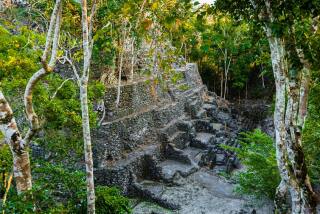Ancient city yielding new clues in Michoacan, Mexico
- Share via
Colorado researchers have discovered and partially mapped a major urban center once occupied by the Purépecha of Mexico, a little-known people who fought the Aztecs to a standstill and who controlled much of western Mexico until diseases brought by the Spanish decimated them.
The “proto-urban center,” which researchers have not yet named, sat on volcanic rock on the shores of Lake Pátzcuaro in the central Mexican state of Michoacan, now a tourist destination. It supported as many as 40,000 people until the consolidation of the Purépecha empire about AD 1350 led most of its inhabitants to relocate to the new capital of Tzintzuntzan, six miles away.
“What’s really interesting about the site is that it gives us a window into the pre-state period when social complexity was increasing and people were congregating together and starting to modify the landscape,” said archaeologist Christopher Fisher of Colorado State University, who will present the findings this week at a St. Louis meeting of the Society for American Archaeology.
Finding that the urban center’s population fell as the capital, Tzintzuntzan, grew will also help rewrite the history of the Purépecha, who were also known as Tarascans, said archaeologist Gary Feinman of Chicago’s Field Museum, who was not involved in the research.
It indicates, he said, that concentration of the population -- rather than population growth as had previously been believed -- “was a critical element in the concentration of power, particularly in Mesoamerica, where you did not have domesticated animals. People were absolutely critical for moving goods, constructing things and producing food.”
Despite the fact that the Purépecha empire was as large and powerful as that of the Aztecs, they “have gotten the short end of the stick as far as public attention goes,” Fisher said.
Much of what we know about the Aztecs comes from the colonial records of the Spanish expeditionary force, he noted, but the Spaniards -- who encountered the Aztecs first -- had little contact with the Purépecha until the civilization was already doomed by disease.
Yet the Purépecha not only controlled most of western Mexico, but had a strongly fortified border with the Aztec empire and ultimately defeated the Aztec army in a fierce battle in the late 15th century.
Part of their strength came from their skill as coppersmiths and, despite the fact that they were fierce enemies, the Aztecs traded extensively with them to acquire copper tools, bells and other valuable objects.
Fisher and his team discovered the site last summer as part of their ongoing survey of the Lake Pátzcuaro basin.
Because the lake level has been dropping, the Purépecha site now sits a couple of miles east of the lake -- Fisher is vague about the precise location because of fears of looting -- but at its height was probably no more than a quarter mile from the shore.
The site sits on a landform called malpais, a young, rugged volcanic landscape “that looks like gravel dumped into a big pile,” he said.
Because the land is not suitable for agriculture, the foundations of structures have been largely preserved.
The site encompasses about 5 square kilometers (about 1,200 acres). Using rugged computers and specialized GPS receivers, the team has carefully mapped about a fifth of the site, recording more than 1,300 features, including house mounds, room blocks, buildings, small temples, plazas and agricultural terraces.
Such detailed mapping “is quite revolutionary because it gives us a chance to see what the economic picture was, and the social differentiation,” said archaeologist Barbara Stark of Arizona State University, who was not involved in the research. “It’s hard to describe how important that is for our understanding of these societies.”
Most of the site dates from AD 1000 to about 1350, when it began to shrink as the population moved elsewhere. By 1500, it was largely abandoned.
Most of the rest of the empire disappeared soon after. Smallpox and other diseases that were spread to the Aztecs by the Spanish were transmitted to the Purépecha as well, killing 80% to 90% of the population. By the time the Spanish attacked the Purépecha, there was hardly anyone left to resist.
thomas.maugh@
latimes.com
More to Read
Sign up for Essential California
The most important California stories and recommendations in your inbox every morning.
You may occasionally receive promotional content from the Los Angeles Times.













